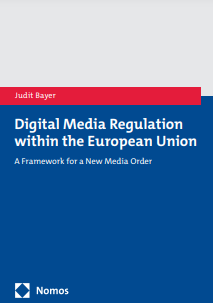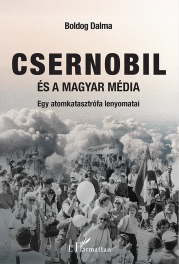Contents – Autumn-Winter 2022
Gayer, Zoltán:
Gayer, Zoltán:
What is a Medium?
This paper argues that the internet is not a medium. Rather, one should consider media the applications and websites the internet is a channel for. It defines a medium as an algorithm-based encoding system linked to a data structure. It also suggests a typology to define all media, old and new.
Keywords: algorithm, internet, Facebook, media, medium, television, TikTok, radio
Médiakutató Autumn-Winter 2022 pp. 7-28
Polyák, Gábor:
Polyák, Gábor:
Media in Hungary: Three Pillars of an Illiberal Democracy
The paper summarises the main tools of Viktor Orbán’s illiberal media policy. These tools can be grouped into three pillars. First, it presents the new organisational framework that has allowed for political influence to be exerted through the supervisory boards, then it offers an analysis of the tools of market manipulation, and finally it looks into how the ruling party dominates political discourse in Hungary.
Keywords: freedom of information, independent media supervision, media policy, press freedom, state advertising, self-censorship
Media in Hungary: Three Pillars of an Illiberal Democracy
Médiakutató Autumn-Winter 2022 pp. 33-47
Bátorfy, Attila:
Bátorfy, Attila:
Hungary: A Country on the Path Toward an Authoritarian Media System
The erosion of the freedom of press in Hungary is a constantly and well-documented fact, accessible to foreign visitors. Political science has competing theories for a systemic understanding of the Hungarian political establishment, but theoretical approaches to the characteristics of the Hungarian media landscape are sporadic and incomplete. In this paper, based on a description of the properties of the Hungarian media system, which has been arbitrarily transformed by the Orbán governments in power since 2010 through administrative-regulatory, state funding and communication tools, I attempt to situate it between classical and recent media system theories and thus complement the observations made so far with some new ones. I will point out that Orbán’s authoritarian ideas about the media have been clear at least since his first government and argue that although the Hungarian media system, despite its mixed features, does not fit into any media system theory, this is only because these theories draw the contours of the dynamically changing media spaces after the fact. Recognising this, I believe, can help us to identify archetypes of media systems when examining the relationship between power and media. I will do this through an illustration of the tools and their effects used for authoritarian media transformation and will argue that the Hungarian media system, among the categories established by Siebert, Peterson and Schramm, is similar in its dynamics to the authoritarian and the Soviet-communist media systems.
Keywords: freedom of press, media and politics, media freedom, media system theories
Hungary: A Country on the Path Toward an Authoritarian Media System
Médiakutató Autumn-Winter 2022 pp. 49-58
Sükösd, Miklós:
Sükösd, Miklós:
Orbán’s victims
This paper explores the key features of Viktor Orbán’s populist rhetoric, which remained essentially the same from 1989 to the 2020s. Orbán speaks in the name of the nation as a whole, envisions dangerous enemies instead of democratic political opponents, and mobilises against an external occupying power. By systematically evoking fear, the desire for revenge, and naming the ever-present enemies, he transforms historically rooted ressentiment, grievance culture and notions of (self)victimisation in Hungarian national identity into active hate politics. With his rhetoric, he awakens the desire for an authoritarian leader who saves us from a fearful and dangerous world with dictatorial state policies. Theoretically, I analyse Orbán’s speeches and their powerful impact with the concepts of speech act theory and securitisation. The texts include Orbán’s famous speech in 1989, and his series of seasonal addresses during the last twenty years (including a secondary analysis of a database of 41 speeches).
Keywords: national identity, orator, political communication, propaganda, ressentiment, rhetorics, securitisation, speech act theory, Viktor Orbán
Médiakutató Autumn-Winter 2022 pp. 59-77
Tófalvy, Tamás:
Tófalvy, Tamás:
Online Harassment of Journalists in Hungary
This report, prepared for the International Press Institute (IPI) in 2017, presents the findings of a study focused on mapping, observing and analysing the online harassment of journalists in Hungary. It is aimed at identifying the types of harassment journalists are subject to, and at mapping which journalists are typically harassed, who the harassers are, and how journalists cope with harassment. The report identified eight basic types of harassment present in Hungary, including rhetorical aggression, trolling, bullying, threats, public shaming, violations of personal privacy, cyber attacks and site hacking, and malicious social media activity. It found that the most common types of online harassment were trolling and rhetorical aggression, experienced by Hungarian online journalists on a daily basis on both public and private channels. Based on the analysis of data, this report defines three main challenges for Hungarian online journalism with regard to the ubiquitous nature of online harassment: a soft chilling effect, a ‘desensitisation effect,’ and the significant volume and intensity of harassment targeted at traditionally oppressed social groups, against women in particular.
Keywords: Hungary, IPI report, journalists, online harassment
Online Harassment of Journalists in Hungary
Médiakutató Autumn-Winter 2022 pp. 79-88
Juhász, Vanessza – Bene, Márton:
Juhász, Vanessza – Bene, Márton:
The online argumentation of political parties and their leaders during the 2022 parliamentary election campaign
Based on the 2022 legislative election campaign, this paper studies how frequently and in what ways certain elements of political debate occur in political actors’ social media communication. We analysed 2,441 Facebook posts issued by parties and party leaders prior to the election. Our findings suggest that political actors engage in opinionated discourse on social media and largely focus on public policy issues. They rarely rely on factual reasoning, but ad hominem fallacy plays a significant role in their Facebook posts. However, other argumentation mistakes occur rarely in their communication. Different actors evince largely identical patterns, but opposition parties and politicians tend to take a more argumentative stance compared to coalition parties and politicians.
Keywords: 2022 parliamentary election campaign, ad hominem, argumentation, Facebook, Frans van Eemeren, political debate, pragmadialectics, social media
Médiakutató Autumn-Winter 2022 pp. 93-107
Benczes, Réka – Szabó, Lilla Petronella – Virág, Ágnes:
Benczes, Réka – Szabó, Lilla Petronella – Virág, Ágnes:
It’s showtime: the politics is a show metaphor in the 2022 election campaign of Fidesz
According to the conceptual metaphor theory of the cognitive linguistic enterprise, we often interpret more abstract concepts in terms of more concrete concepts. Politics is such an abstract concept, which appeared via the concept of show in American culture in the second half of the 20th century. The politics is a show metaphor depicts politicians as the characters of a show, while voters appear as the viewers of the show. This metaphorical interpretation does not carry negative judgement. The politics is a show metaphor appeared in the Hungarian political discourse during the 2022 legislative election campaign in a video entitled Gyurcsány Show. The video interprets politics as a failed show; hence, a negative value judgement can be attributed to the advertisement. Our study explores how the metaphor conceptualising politics as a show (which does not necessarily carry a negative meaning in the American context) has been adapted to contemporary Hungarian politics and how it has acquired an evidently negative meaning in the Hungarian context.
Keywords: conceptual blending, conceptual metaphor, Fidesz, Hungary, negative campaign, political discourse
It’s showtime: the politics is a show metaphor in the 2022 election campaign of Fidesz
Médiakutató Autumn-Winter 2022 pp. 109-121
Lajkó, Ádám:
Lajkó, Ádám:
Freemasonry and the First World War
The theory about Masonry’s responsibility for WWI was a popular idea among interwar far-right intellectuals in Hungary. This paper examines the origins and the context of this interpretation and shows why it could become one of the emotional reference points in the emerging far-right worldview. It demonstrates that speculation about this link appeared in the Hungarian press as early as 1914. The idea first emerged within a radical branch of political Catholicism, hostile to the civic radicals, a francophile ideology closely linked to Masonry. The theory’s focal point was the question of nationality and territorial integrity, its proponents portrayed the irredentist threat against the dual Monarchy as a tool of the Freemasons. After Italy’s entry into the war the idea also appeared in the pro-government conservative daily Budapesti Hírlap. The paper shows that the public diplomacy and geopolitical rhetoric of the Entente states had a catalytic effect on the development of this theory: its proponents interpreted the Hungarian civic radicals as a force representing the interests of the Entente. Finally, the paper shows that this early interpretation played a founding role in the birth of the theories attributing the Trianon Peace Treaty to the influence of the Masons.
Keywords: civic radicals, far-right world view, first world war, masonry, nationality question, political Catholicism
Freemasonry and the First World War
Médiakutató Autumn-Winter 2022 pp. 125-134
Fejes, Katalin:
Fejes, Katalin:
The woman who dictated and controlled fashion in the 1930s: Böske Guthy
Böske Guthy’s ten-year-long career as a fashion journalist is unparalleled in the journalism of the 1930s. She was present at almost every representative event, shaped the style of the modern woman with her writings, and her name was synonymous with the image of the modern woman. The journalist of Jewish origin, as the editor of the fashion column of Színházi Élet, shaped the bourgeois form of social representation in an era of Hungarian social history when the bourgeois value system that she represented gradually receded into the background. Böske Guthy’s professional career is closely linked to Színházi Élet. Due to her social status, the fashion section editor of the popular magazine of the era shaped the fashion of everyday life, and therefore had a significant influence on collective representation through the representation of the writings and photos published in the magazine.
Keywords: fashion journalist, Horthy era, Jewish history, modern woman, social representation
The woman who dictated and controlled fashion in the 1930s: Böske Guthy
Médiakutató Autumn-Winter 2022 pp. 135-143




